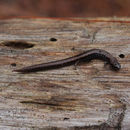Description
provided by AmphibiaWeb articles
Thorius papaloae is a small salamander, with a pointed snout, large, elliptical nostrils, and moderately large eyes, which protrude slightly. Adult standard length averages 20.4mm (males) and 21.6mm (females). The head is relatively broad, and the tail is relatively long.Hanken and Wake (2003) describe Thorius papaloae as a "relatively dark species, with some indication of an obscure dorsal band in most individuals". Specimens with the lightest band have a herringbone pattern middorsally.The venter is dark, but lighter than the flanks, while the underside of the tail is particularly light. The gular region has many white spots. The species has no maxillary teeth. As for osteology: the skull is poorly ossified, even compared to other species of Thorius. The premaxilla generally bears teeth, while the nasal bone is thin and rod-like. Prefrontal and maxilla are separate. The species has 14 presacral vertabrae, all but the last of which typically bear ribs. Recognition of Thorius papaloae as a new species is justified on account of genetic differentiation from other named species, substantial geographic distance from populations of its nearest congeners, and subtle morphological features (Hanken and Wake 2001).All information for this account comes from "A Seventh Species of Minute Salamander (Thorius: Plethodontidae) From the Sierra Juárez, Oaxaca, México" (Hanken and Wake 2001).
Hanken, J. and Wake, D. B. (2001). ''A seventh species of minute salamander (Thorius: Plethodontidae) from the Sierra de Juárez, Oaxaca, Mexico.'' Herpetologica, 57(4), 515-523.
Distribution and Habitat
provided by AmphibiaWeb articles
Thorius papaloae is only known to live at the northwestern edge of the Sierra Madre in north-central Oaxaca, México, to the northeast of the village of Concepción Pápalo. The dominant habitat is pine and pine-oak forest, between elevations of 2500 and 2850m. The species can be found beneath cover objects on the forest floor, and beneath the bark of fallen logs, often in moist microhabitats on north-facing wooded slopes (Hanken and Wake 2001).

